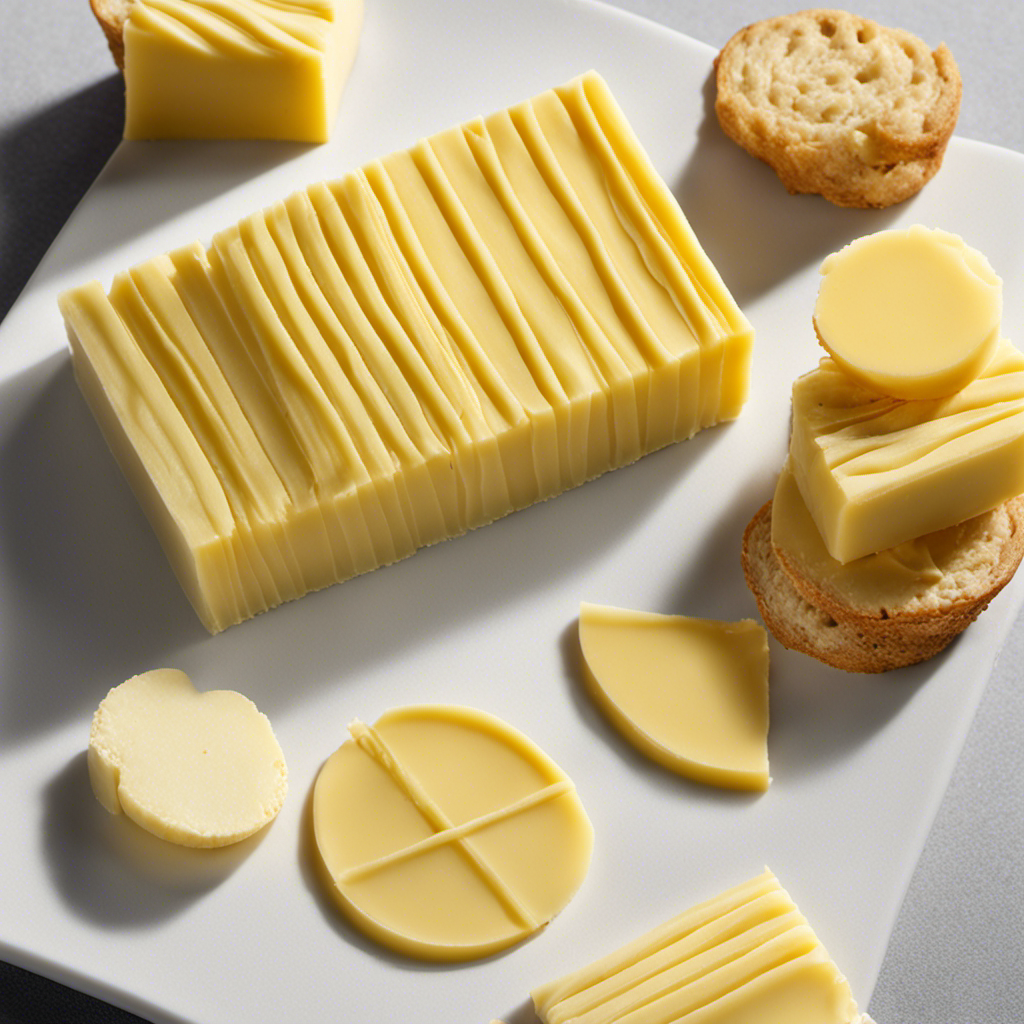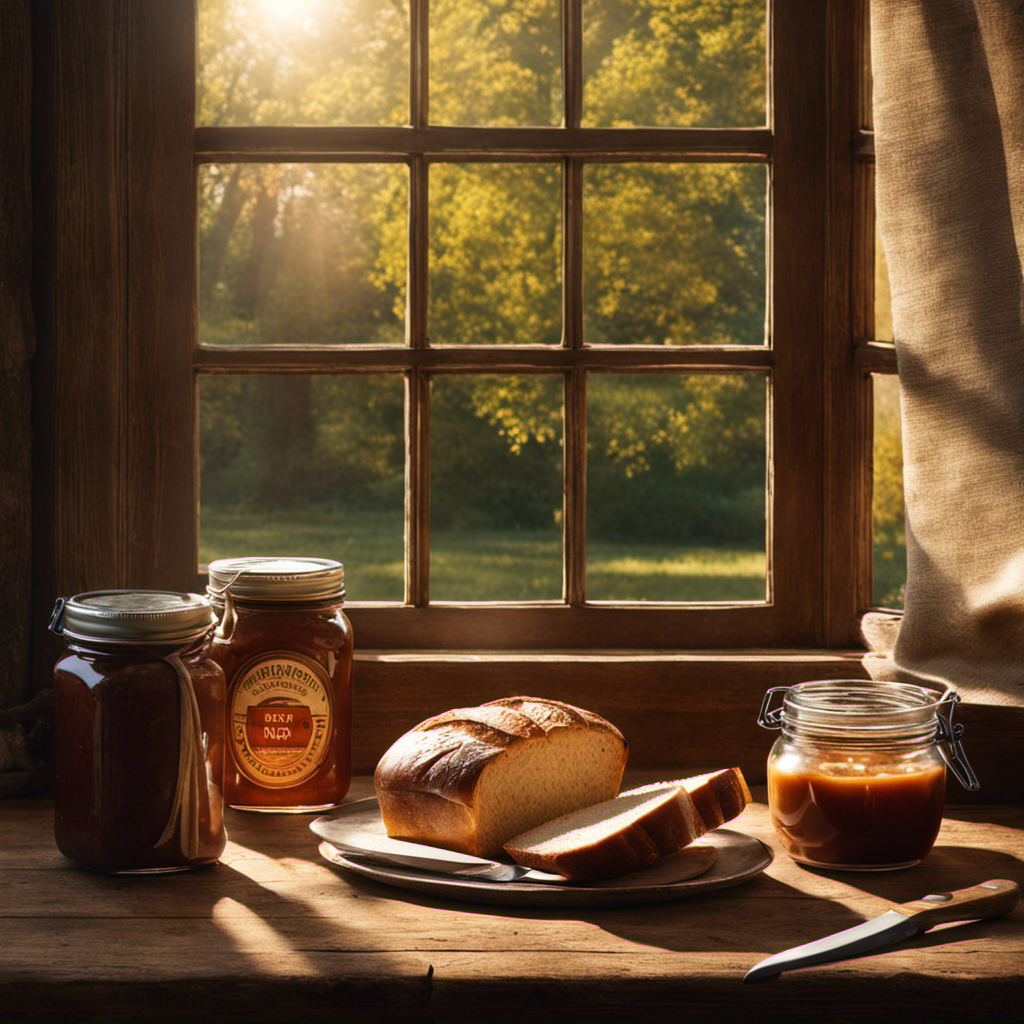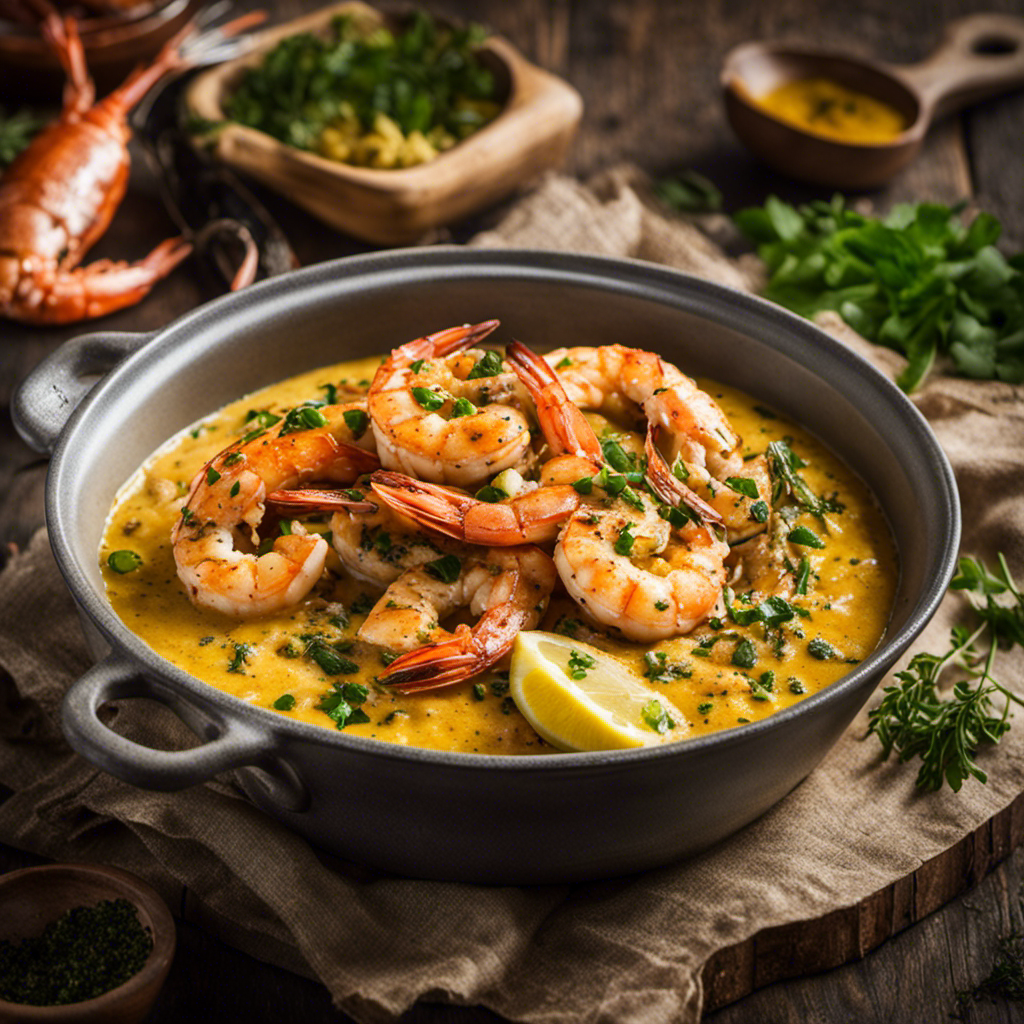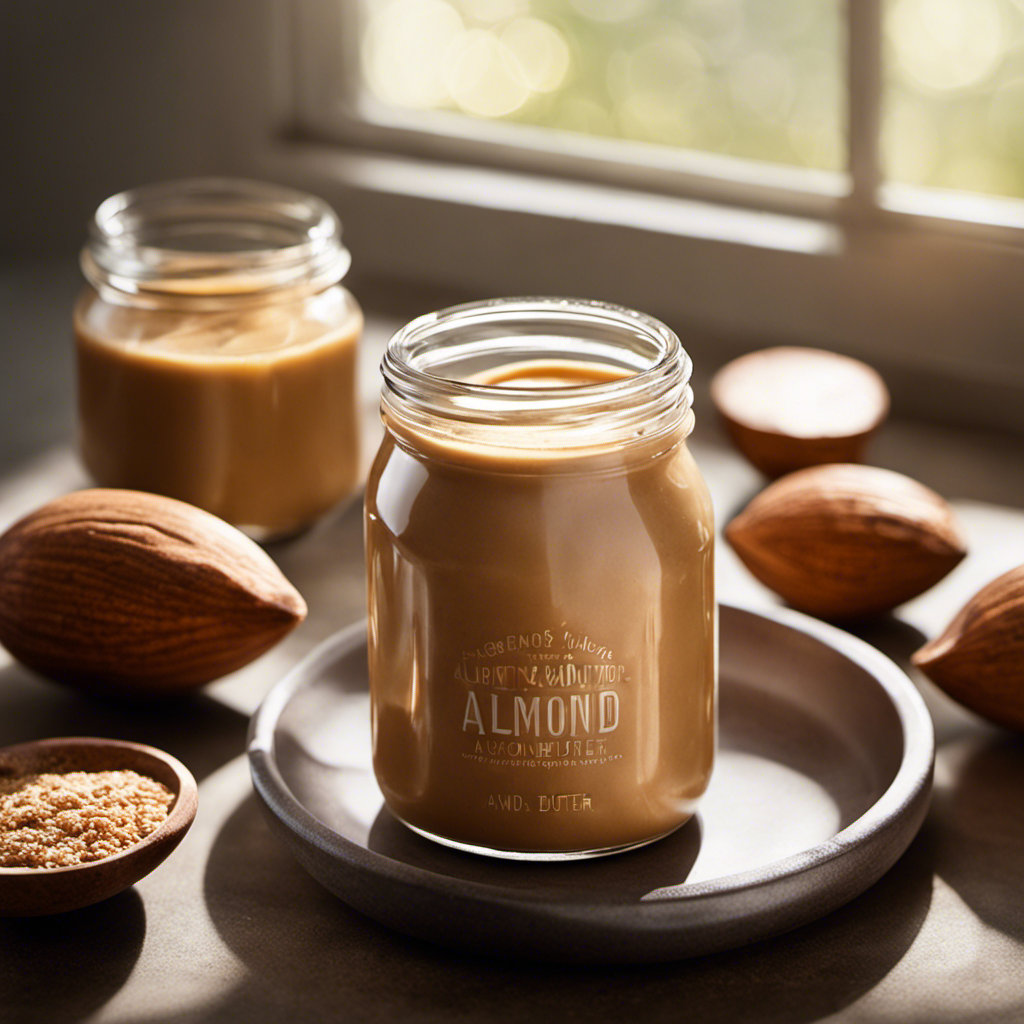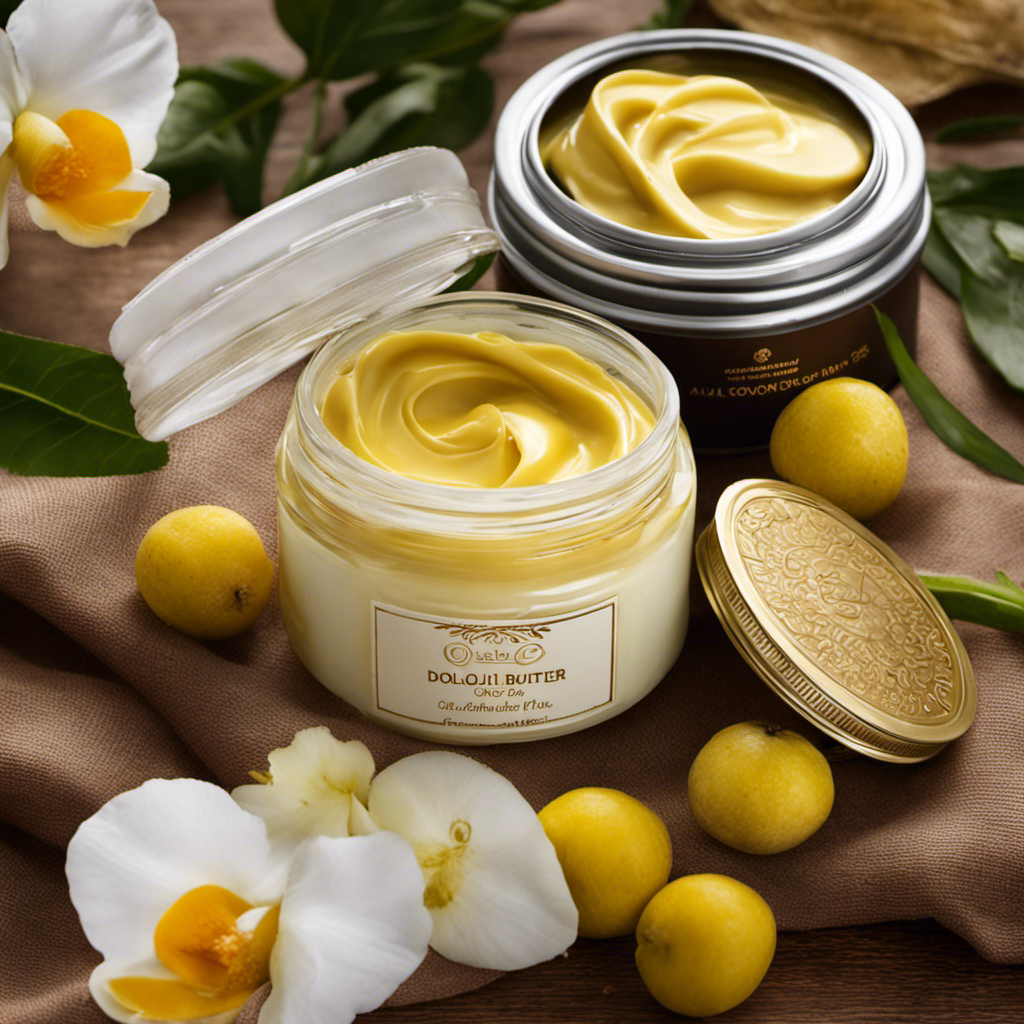As a nutritionist, I have always been intrigued by the intricate interplay of flavors in our food. Salt, much like the conductor of an orchestra, plays a vital role in butter, bringing harmony to all the other ingredients.
In this article, we will delve into the question of how much salt is present in a stick of butter. By understanding the importance of salt in butter and exploring different salt varieties used, we can unlock a world of flavor possibilities in our culinary endeavors.
Key Takeaways
- Salt in butter enhances its flavor and makes it more savory and appealing.
- Excessive salt intake can have negative health effects, so moderation is recommended.
- The salt content in butter can vary significantly and has implications for diet and health.
- Different salt varieties can impact the taste and quality of butter, and experimenting with flavored salts can elevate the taste of butter-based creations.
Why Is Salt Added to Butter
Salt is commonly added to butter for both health benefits and its impact on taste. From a health perspective, adding salt to butter can help enhance the flavor of foods, which in turn can encourage people to consume more nutrient-rich foods. Additionally, salt acts as a preservative, helping to extend the shelf life of butter.
When it comes to taste, salt enhances the natural flavors of butter, making it more savory and appealing to the palate. It can also help balance out any bitterness or sourness in the butter. However, it is important to note that excessive salt intake can have negative health effects, so it is recommended to consume butter in moderation.
The Importance of Salt in Butter
The addition of salt enhances the flavor of butter. Salt plays a crucial role in the overall taste of butter, as it brings out the natural richness and creaminess.
Here are three key reasons why salt is important for seasoning butter and its impact on taste:
-
Flavor enhancement: Salt acts as a flavor enhancer, intensifying the taste of butter and making it more enjoyable to consume.
-
Balance and complexity: Salt helps to balance out the flavors in butter, adding a subtle complexity that enhances the overall taste experience.
-
Preservation: Salt acts as a natural preservative, helping to extend the shelf life of butter while maintaining its quality and taste.
Understanding the importance of salt in butter is the first step in comprehending the salt content in butter and its impact on our diet and health.
Understanding Salt Content in Butter
When it comes to butter, the salt content can vary significantly. Understanding this variability is crucial, as it can have implications for our health.
In this discussion, we will explore the differences in salt content between salted and unsalted butter, and delve into the potential health effects associated with consuming excessive amounts of salt.
Salt Content Variability
There’s always a variation in the salt content of a stick of butter. This variability in salt content has a significant impact on the taste of butter. To understand the salt content in butter, several factors need to be considered:
- Source of milk: Different breeds of cows produce milk with varying levels of natural salt content.
- Butter-making process: The amount of salt added during the butter-making process can vary depending on the manufacturer’s recipe.
- Storage conditions: Butter stored in different environments can absorb moisture, affecting its salt content.
Analyzing the salt content of butter is crucial for maintaining consistency in recipes and achieving desired flavor profiles. By understanding the factors that contribute to salt content variability, we can make informed decisions when selecting butter for specific culinary purposes.
Transition: Now that we’ve explored the variability in salt content, let’s delve into the health implications of consuming salt in butter.
Health Implications of Salt
To maintain a healthy diet, it’s important to be mindful of the amount of salt you consume in your food choices. Excessive salt intake can lead to various health risks, including high blood pressure, heart disease, stroke, and kidney problems.
The recommended intake of salt for an average adult is around 2,300 milligrams per day, which is roughly equivalent to one teaspoon. However, it’s crucial to note that individual needs may vary based on factors such as age, sex, and existing health conditions.
It’s always advisable to consult with a healthcare professional to determine the appropriate amount of salt for your specific needs.
Now, let’s delve into comparing salted vs. unsalted options to better understand their impact on our health.
Comparing Salted Vs. Unsalted
Let’s explore the differences in health effects between choosing salted and unsalted options.
When it comes to taste, salted butter has a distinct, savory flavor due to the addition of salt. This can enhance the overall taste of certain dishes, especially those that require a hint of saltiness.
On the other hand, unsalted butter provides a more neutral flavor, allowing other ingredients in a recipe to shine.
In terms of the impact on recipe flavor, using salted butter can add depth and complexity to dishes like sauces, pastries, and bread. However, it’s important to consider the sodium content when using salted butter, especially for individuals with hypertension or other health concerns.
Unsalted butter gives you more control over the amount of salt in your recipes, allowing you to adjust and balance flavors according to your preference.
Ultimately, whether you choose salted or unsalted butter depends on your taste preferences and dietary needs.
Common Salt Varieties Used in Butter
When it comes to butter, not all salts are created equal. Understanding the types of salt used in butter and how they can vary is an important aspect to consider.
Different salts can have varying flavors, textures, and levels of saltiness, which can ultimately impact the taste and overall quality of the butter.
Types of Salt
You might be surprised by the different types of salt available to enhance the flavor of your stick of butter. Here are some common salt varieties and their variations:
-
Table Salt:
-
Iodized salt: Contains iodine, which is essential for thyroid health.
-
Non-iodized salt: Does not contain iodine and is often used in baking.
-
Sea Salt:
-
Celtic sea salt: Harvested from the coasts of France, it has a distinct briny flavor.
-
Himalayan pink salt: Mined from ancient salt deposits in the Himalayan Mountains, it is rich in minerals.
-
Kosher Salt:
-
Diamond Crystal kosher salt: Light and flaky, it is widely used in cooking and has no additives.
-
Morton kosher salt: Coarser than table salt, it is commonly used to draw out moisture in meat.
-
Flavored Salt:
-
Smoked salt: Infused with smoky flavor, it adds depth to dishes.
-
Truffle salt: Combines salt with truffle pieces or oils for a gourmet touch.
Experimenting with different types of salt can elevate the taste of your butter-based creations.
Salt Variations in Butter
To enhance the flavor of your butter-based creations, consider using different types of salt variations.
Salt plays a crucial role in enhancing the taste of any dish, and when it comes to butter, the right salt can elevate the flavors to new heights.
Salt variations offer different levels of salt concentration, allowing you to tailor the taste according to your preference. Whether you’re making salted butter recipes like cookies, cakes, or savory dishes, experimenting with different salt types can make a noticeable difference.
From kosher salt to sea salt or even flavored salts like smoked salt or truffle salt, each variation brings its unique touch to your buttery creations.
Salt in Butter?
Consider experimenting with different types of salt variations to enhance the flavor of your butter-based creations. Salt plays a crucial role in butter, not only in its taste but also in its texture.
Here are some key points to keep in mind when it comes to the salted vs. unsalted debate and the impact of salt on butter’s texture:
-
Salted butter: Contains added salt, providing a savory taste and enhancing the overall flavor of dishes. However, the amount of salt can vary between brands, so it’s important to taste and adjust accordingly.
-
Unsalted butter: Does not contain added salt, allowing for more control over the saltiness of your dishes. It is often preferred in baking recipes, as it allows you to have complete control over the amount of salt added.
-
Impact on texture: Salt can affect the texture of butter, making it softer or harder depending on the amount used. It also helps to preserve the butter and extend its shelf life.
Experimenting with different salt variations can help you find the perfect balance of flavor and texture in your butter-based creations. So go ahead, get creative, and elevate your dishes with the right amount of salt.
Salted Vs. Unsalted Butter: Which Is Better
Salted butter and unsalted butter each have their own unique flavors and uses.
Salted butter, as the name suggests, contains salt. The addition of salt enhances the flavor of the butter, making it more savory and rich. This makes salted butter a great choice for spreading on bread or adding to savory dishes like roasted vegetables or mashed potatoes. The salt in salted butter also acts as a natural preservative, extending its shelf life.
On the other hand, unsalted butter does not contain any salt. This allows for more control over the saltiness of a dish, making it ideal for baking where precise measurements are crucial. Additionally, unsalted butter is often preferred in recipes where the butter flavor needs to shine through without any interference from salt.
Ultimately, the choice between salted and unsalted butter depends on personal preference and the specific recipe at hand.
How Much Salt Is Typically Added to Butter
The amount of salt typically added to butter varies depending on the brand and recipe. Salt content in butter can also be influenced by cultural preferences and traditions in different countries. When it comes to salted butter, there are some variations to consider:
- In some countries, such as France, salted butter is quite common and often contains a higher salt content compared to other countries.
- Cultural influences on salt consumption can play a role in the salt content of butter. For example, in countries with a preference for less salty foods, the salt content in butter may be lower.
- Recipe variations also contribute to the salt content. Some recipes call for unsalted butter while others specify salted butter.
Understanding the different salt content in butter is important for individuals who need to monitor their sodium intake or for those who prefer a certain level of saltiness in their dishes.
Now, let’s explore the salt content in different brands of butter.
Salt Content in Different Brands of Butter
In my analysis of different brands of butter, I focused on the salt content present in each. Salt plays a crucial role in enhancing the flavor of butter. It not only adds a savory taste but also helps to balance out the richness of the butter.
Through my research, I found that the salt content varied among different brands. Some brands had a higher salt content, resulting in a more pronounced salty flavor, while others had a lower salt content, resulting in a milder taste.
It is important to note that the impact of salt on butter flavor is subjective and varies depending on individual preferences. By understanding the salt content in different brands of butter, consumers can make informed choices based on their desired flavor profile.
Does the Salt Content in Butter Vary by Country
In exploring the global salt content differences and cultural influences on salt, it is important to understand how varying levels of salt can be found in different food products across countries.
These differences can arise from factors such as regional preferences, traditional cooking methods, and cultural dietary habits.
Global Salt Content Differences
Contrary to popular belief, there’s a noticeable difference in salt content across different regions worldwide. This variation in salt content is influenced by factors such as global salt production and salt consumption patterns. Here are three key points to consider:
-
Salt production: Different regions have varying levels of salt production, with countries like China, the United States, and India being the top producers. This disparity in production can lead to differences in the availability and use of salt in different regions.
-
Cultural preferences: Salt consumption patterns are greatly influenced by cultural preferences and dietary habits. For example, countries with a higher consumption of processed foods or a preference for salty snacks may have higher salt content in their regional produce.
-
Health considerations: The variation in salt content across different regions is also driven by health considerations. Some countries actively implement salt reduction strategies to combat health issues like hypertension and cardiovascular diseases.
Understanding these global differences in salt content is crucial for individuals and policymakers alike to make informed choices about their salt intake and overall health.
Cultural Influences on Salt
In exploring the global differences in salt content, it is important to consider the cultural influences on salt consumption. Cultural traditions and dietary habits play a significant role in determining the amount of salt people consume in their daily lives. For instance, in some Asian countries, such as Japan and China, soy sauce is a staple condiment that is high in sodium. This contributes to a higher overall salt intake in these cultures. On the other hand, Mediterranean countries, like Greece and Italy, have a diet rich in fruits, vegetables, and whole grains, which are naturally low in sodium. As a result, their dietary habits tend to have lower salt content. Understanding these cultural influences is crucial in developing strategies for reducing salt intake and promoting healthier lifestyles worldwide.
| Cultural Traditions | Dietary Habits |
|---|---|
| Asian countries | High salt intake due to soy sauce as a staple condiment |
| Mediterranean countries | Low salt intake due to diet rich in fruits, vegetables, and whole grains |
How to Measure Salt Content in Butter
To measure the salt content in butter, you can use a simple kitchen scale. This method allows for measuring accuracy and helps in determining the amount of salt present in a stick of butter.
Here are some salt detection methods that can be used with a kitchen scale:
-
Visual Inspection:
-
Look for visible salt crystals on the surface of the butter.
-
Examine the texture of the butter for any granular or gritty feel, which may indicate a higher salt content.
-
Tasting:
-
Take a small amount of butter and taste it.
-
Pay attention to the saltiness level and compare it with your own taste preferences or a reference point.
-
Chemical Analysis:
-
Use a salt detection kit or a laboratory analysis to measure the exact salt content in the butter.
Health Effects of Consuming Salted Butter
Eating salted butter can have various impacts on your health. Consuming excessive amounts of salt can lead to health risks such as high blood pressure and an increased risk of heart disease. It is important to note that the recommended intake of salt for adults is no more than 2,300 milligrams per day, which is roughly equivalent to one teaspoon.
However, the salt content in butter can vary depending on the brand and type. On average, a stick of salted butter contains approximately 115 milligrams of sodium per tablespoon. This means that consuming a moderate amount of salted butter can be part of a balanced diet, as long as overall salt intake is kept in check.
As always, it is important to consult with a healthcare professional or nutritionist for personalized dietary advice.
Low-Sodium Alternatives to Salted Butter
In this next subtopic, we will explore low-sodium alternatives to salted butter and their potential health benefits.
As someone who is conscious of my sodium intake, I’m always looking for healthier options that can still satisfy my taste buds.
Butter Substitutes for Sodium
Did you know there are butter substitutes available that are lower in sodium?
When it comes to finding alternatives to butter that are lower in sodium, there are a few options to consider:
-
Olive Oil: Olive oil can be used as a substitute for butter in many recipes. It is not only lower in sodium but also contains heart-healthy fats.
-
Avocado: Mashed avocado can be used as a spread or as a replacement for butter in baking. It adds a creamy texture and provides healthy monounsaturated fats.
-
Greek Yogurt: Greek yogurt can be used as a substitute for butter in recipes like muffins and cakes. It adds moisture and a tangy flavor, while also being lower in sodium.
Health Benefits of Alternatives
You’ll be pleasantly surprised by the numerous health benefits that these butter alternatives offer.
Low sodium butter options not only provide a delicious taste but also help reduce the health risks associated with excessive salt intake. Consuming too much sodium can lead to high blood pressure, heart disease, and stroke.
By choosing low sodium butter alternatives, you can enjoy the rich flavor of butter without compromising your health. These alternatives are often made from natural ingredients and are lower in sodium content compared to traditional butter.
They can be used in a variety of recipes, from baking to cooking, and are a great way to reduce your overall salt intake. So, let’s explore how to reduce salt in salted butter recipes and make healthier choices in our daily cooking.
How to Reduce Salt in Salted Butter Recipes
To reduce salt in salted butter recipes, try using unsalted butter instead. This simple substitution can significantly lower your sodium intake while still allowing you to enjoy the rich flavor of butter.
Here are three flavor enhancement techniques to make up for the lack of salt:
-
Add herbs and spices: Experiment with herbs like thyme, rosemary, or basil, and spices like paprika or garlic powder. These ingredients can bring a burst of flavor to your dishes without the need for salt.
-
Use citrus zest: Grate the zest of lemons, limes, or oranges into your recipes. The natural oils in the zest can provide a bright and tangy flavor that complements the richness of butter.
-
Try umami-rich ingredients: Incorporate ingredients like mushrooms, soy sauce, or Parmesan cheese. These umami-packed foods can enhance savory flavors and make up for the absence of salt.
Salted Butter in Baking: Tips and Tricks
When it comes to baking, using salted butter can add a delightful touch to your creations. The salt content in salted butter enhances the flavor profile of baked goods, giving them a deliciously balanced taste. While the exact amount of salt in a stick of salted butter can vary by brand, it typically contains about 1/4 teaspoon or 1.4 grams of salt. This small amount may not seem significant, but it can make a noticeable difference in the final outcome of your baked treats.
Here are some benefits of using salted butter in baking:
| Benefits of Salted Butter | Description |
|---|---|
| Enhanced flavor | Salted butter adds a savory element to baked goods, intensifying their taste. |
| Convenience | Using salted butter eliminates the need to measure and add salt separately. |
| Improved texture | The salt in salted butter can help regulate gluten development, resulting in a better texture. |
| Longer shelf life | The salt acts as a preservative, extending the shelf life of baked goods. |
| Versatility | Salted butter can be used in a variety of sweet and savory recipes, adding complexity to both. |
Salted Butter in Cooking: Enhancing Flavors
Using salted butter in your cooking can enhance the flavors of your dishes, adding a savory element that elevates the taste. The salt in the butter helps to balance the flavors, bringing out the natural sweetness of ingredients and enhancing the overall taste profile.
When using salted butter, consider the following tips to optimize flavor balance:
- Experiment with different brands of salted butter to find the one that suits your palate.
- Adjust the amount of additional salt in your recipe based on the saltiness of the butter.
- Use salted butter in savory dishes like sautés, sauces, and roasted vegetables for an extra layer of flavor.
Exploring the Flavor Profile of Salt in Butter
You can discover a wide range of flavors by exploring the different levels of saltiness found in various brands of butter. When it comes to baking, using salted butter can add a subtle savory note to your recipes. The salt in butter not only enhances the flavor of baked goods, but it also helps to balance out the sweetness. In butter-based sauces, salt plays a crucial role in enhancing the overall taste profile. It helps to bring out the flavors of other ingredients and adds depth to the sauce. However, it is important to note that the amount of salt in butter can vary between brands, so it is always a good idea to taste and adjust the seasoning accordingly.
| Brand | Salt Content (per 100g) |
|---|---|
| Brand A | 1.5g |
| Brand B | 1.2g |
| Brand C | 1.8g |
| Brand D | 1.0g |
Frequently Asked Questions
What Are the Health Effects of Consuming Salted Butter?
When you consume too much salt, it can have negative effects on your health. It’s important to limit sodium intake because it can contribute to high blood pressure, heart disease, and other health problems.
How Much Salt Is Typically Added to Butter?
Typically, a stick of butter contains about 1/4 teaspoon of salt. However, it’s important to note that consuming too much salt can have negative health effects and may exceed recommended sodium intake levels.
Does the Salt Content in Butter Vary by Country?
The popularity of salted vs unsalted butter varies, but both are commonly used. Salt plays a crucial role in the butter making process, enhancing flavor and acting as a preservative. The salt content in butter can vary by country.
How Can I Measure the Salt Content in Butter?
Measuring the salt content in butter can be a tricky task. There are various methods available, such as titration or using a conductivity meter. These techniques allow for precise determination of the salt content.
What Are Some Low-Sodium Alternatives to Salted Butter?
Low sodium spreads and butter substitutes are great alternatives to salted butter. They provide a healthier option by reducing the amount of sodium in your diet. These alternatives can still provide the creamy texture and taste you desire.
Conclusion
In conclusion, salt is the secret ingredient that elevates the taste of butter to new heights. Like a symphony conductor, it harmonizes the flavors, creating a rich and savory experience.
Understanding the salt content in butter allows us to make informed choices in our culinary adventures. Whether we prefer the robustness of salted butter or the versatility of unsalted, both have their merits.
So, next time you indulge in a stick of butter, savor the subtle dance of flavors, knowing that salt is the unsung hero in this delicious tale.

